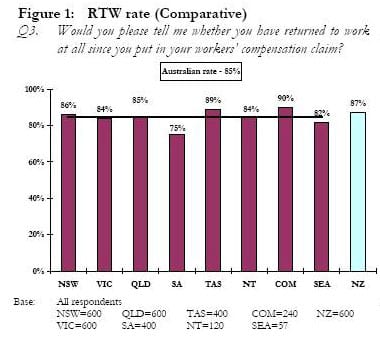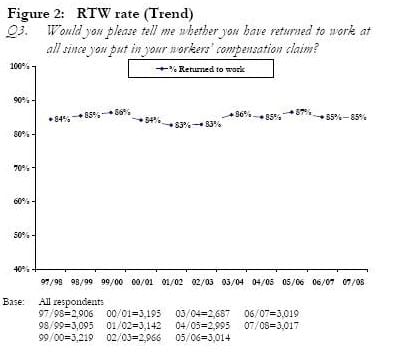RTW performance VS funding performance
Durable and non-durable RTW rates and duration vary within Australian jurisdictions. As the 11th RTW Monitor shows, improvements in scheme funding performance don't necessarily translate to improvements in RTW.
The RTW Monitor is an annual report prepared on behalf of The Heads of Workers’ Compensation Authorities, which looks at workers’ comp jurisdictions in Australia and New Zealand. This year’s report draws on surveys with 3017 injured Australian workers and 600 from New Zealand.
We look at what the 11th RTW Monitor revealed about durable and non-durable RTW.
In 07/08, 85% of Australian workers had returned to work for some period of time within the first six months of making their claim, but weren’t necessarily working at the time they were interviewed. The RTW rate varied between jurisdictions. It was:
- Higher for workers covered by Comcare (90%) and Tasmania (89%); and
- Lower for workers in South Australia (75%).
Since 1997, the average Australian RTW rate has fluctuated slightly, ranging between 83% and 87%.
Figures 1 and 2 illustrate these rates and are from the Return to Work Monitor.


Durable RTW is comprised of only those workers who have returned to work and who are still working when interviewed for the study. The durable RTW rate is generally about ten percentage points lower than the RTW rate, and fluctuates similarly.
As illustrated above, the average Australian durable RTW rate has fluctuated from 97/98 until now. The last three Monitors have shown a steady decline in durable RTW, from 80% to 75%, where it now sits. During this same three year period, scheme funding performance has improved, however this improvement has not translated to an improvement in durable RTW.
In 07/08, durable RTW varied across jurisdictions and was:
- Highest for workers covered by Comcare (84%); and
- Lowest in South Australia (64%).
Making up the 25% of injured, Australian workers who were NOT working at the time they were interviewed for this study:
- 15% had not returned to work at all; and
- 10% had had a non-durable RTW.
In New Zealand:
- The durable RTW rate was 80% (compared to 75% in Australia);
- 13% of injured workers had not returned to work at all; and
- 8% had had a non-durable RTW.
Within Australia in 07/08, the average length of time back at work for injured workers who WERE working at the time of interview was 145 days, or 21 weeks. Durable RTW duration peaked in 03/04 at 159 days. It has since declined and is now at its lowest level since the Monitor began.
Durable RTW duration varied between Australian jurisdictions. It was:
- Higher for workers covered by Comcare (189 days) and in the Northern Territory (170) and Tasmania (163); and
- Lower in Queensland (133 days).

